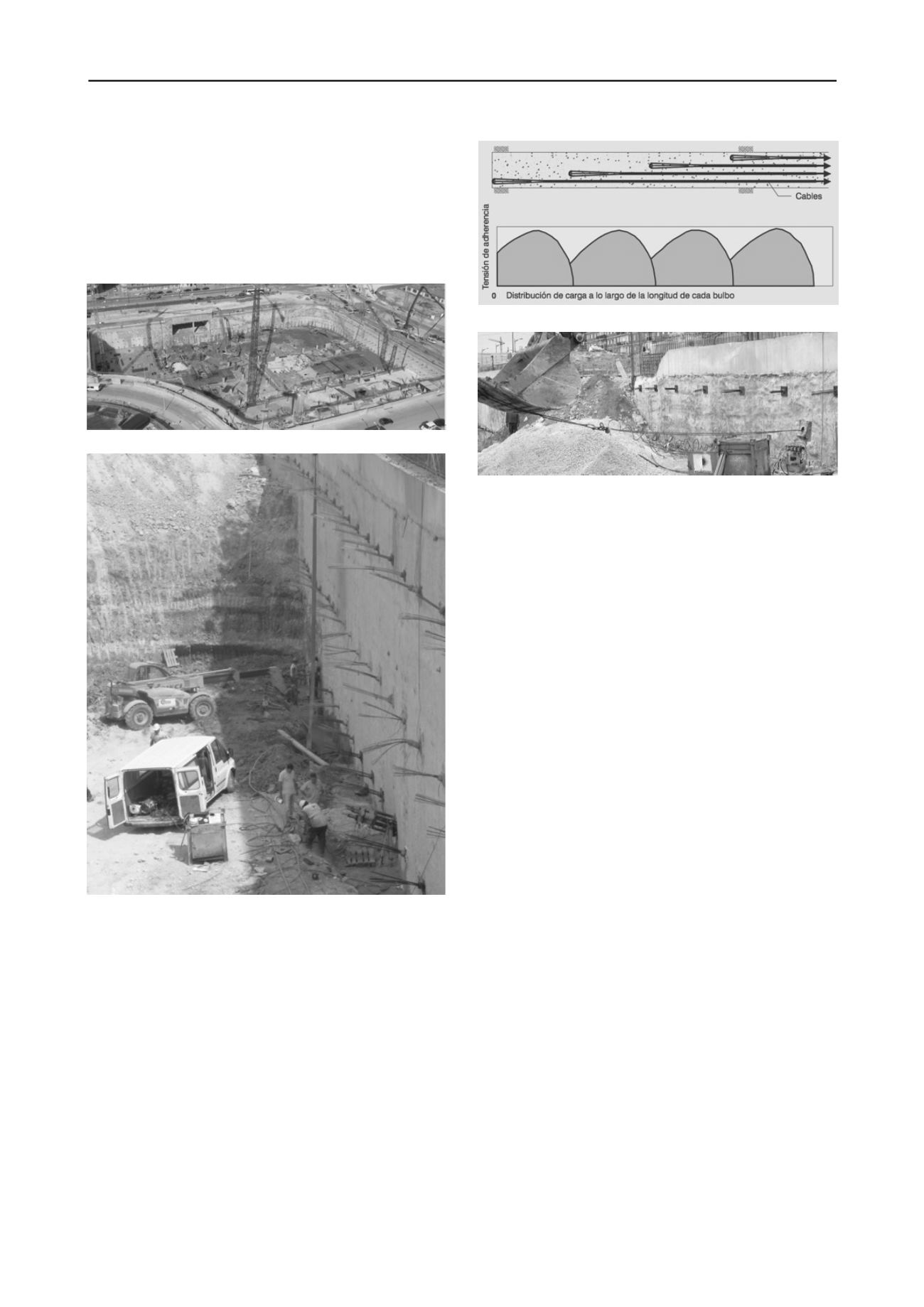
1974
Proceedings of the 18
th
International Conference on Soil Mechanics and Geotechnical Engineering, Paris 2013
design load, using three and four units in clays and silts of
medium consistency, supporting a diapraghm wall of 0,80 m
thickness with a water head of 10 meters. The were employed
four rows of anchors, the first line with traditional anchors and
the other three with SBMA.
In the prelimiary research trials, within the present
cohesives soils (N
SPT
< 8), the distribution of the adhesion along
the fixed lengths tested was close to linear. The same is known
of loose granular soils.
Figure 13. General
view of the jobsite at design excavation level.
Figure 14. Execution of acceptance tests in El Corte Ingles
Within the reference work, we tested the use of multiple
removable anchors as a modern solution to urban problems of
public land use. This anchor also employs several units, each
consisting of a single tendon lubricated and encapsulated in its
entire length, which is bent in a special chair 180 degrees. The
chair has a steel bar and the whole performes as a compression
anchor, which transfers the load to the cement grout and ground.
Thereof the anchorage capacity determines the number of units.
The cable of each unit is then removed by pulling one of its
ends. The complete withdrawal of steel anchors once their
useful life is due, freeing of "pollution" of the ground for future
use (subway/metro, underground pipes, buildings with deep
foundations or basements, etc.)
Figure 15. Removable SBMA units,
schematic arrangement.
Figure 16.
Removing an anchor unit with a force of 50-150 kN.
5.
CONCLUSIONS
SBMA ground anchors are currently the most advanced
technology for greater efficiency in the use of high adhesion
capacity of the ground by the technologies currently employed
in the execution of post-tensioned anchors. This system
increases the limit loads traditional anchors used in soils, and
innovation in paradigms hitherto employed in reference to the
design and implementation of the fixed length of an anchor.
The efficiency factor should be complemented with more test
data from different soil units with different consistency or
relative density; so further detailed test trials research for the
better understanding of each geotechnical unit is to be done.
Meanwhile, there is experience accumulated in the countries
where this technique has been being used the last 20 years.
6.
ACKNOWLEDGEMENTS
The author thanks Kellerterra S.L. for the information herein
presented, acquired during his service as its Technical Director.
Also I am grateful of having met Tony Barley, and having
shared professionally and personally these presented works.
7.
REFERENCES
Barley, A.D. 1995. Theory and practice of the Single Bore Multiple
Anchor System. Anker in Theorie and Praxis.
Proc. Int. Symposium
Salzburg Okt
. Balkema Rotterdam, 293-301
Barley A.D. and C.R. Windsor. (2000). ìRecent advances in ground
anchor and ground reinforcement technology with reference to the
development of the artî. GeoEng 2000 International Conference,
November 19-21, Melbourne, Australia.
Barley, A.D., Ostermayer, H. 2003. Ground Anchors. Geotechnical
Engineering Handbook, Ernst & Sohn, 169-215.
Fernández Vincent, J.M., 2005. Anclajes de Bulbo Múltiple. 5ª Sesión,
Jornadas Técnicas SEMSIG-AETESS – Madrid.
Fernández Vincent, J.M., 2010. Teoría y práctica del anclaje de bulbo
múltiple. XX Congreso argentino de Mecánica de Suelos e
Ingeniería Geotécnica, Mendoza, Argentina. 457- 464.
Fernández Vincent, J.M., 2011. Casos de aplicacion del anclaje de
bulbo múltiple. 14th Pan-American Conference on Soil Mechanics
and Geotechnical Engineering. Toronto, Canada.
Ostermayer, H. (1974). ìConstruction carrying behaviour and creep
characteristics of Ground Anchorsî. ICE Conference on Diaphragm
Walls and Anchorages, London, pp. 141-151.
UNE 1537 – Execution of special geotechnical works - Ground anchors.


